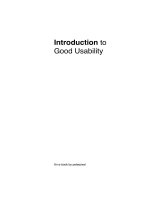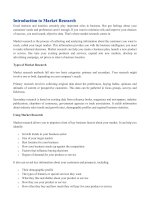Introduction to good usability
Bạn đang xem bản rút gọn của tài liệu. Xem và tải ngay bản đầy đủ của tài liệu tại đây (583.04 KB, 21 trang )
Introduction to
Good Usability
An e-book by peterpixel
released under creative commons
some rights reserved
Peter Conradie (2008)
Contents
Introduction 4
Why Read it? 4
Why Write it? 4
In General 5
Stick to the Rules 5
Borrow 5
You are Less Interesting Than you Think 5
Interface Design Guides 6
Breadcrumbs 6
Tabs 7
Linking 8
Overlays 11
Drop Down Menu 13
Scroll 14
Icons 15
Content 16
Titles 16
Splash Screen 16
Body Text 17
Fonts 17
Video 18
Further Reading 20
Introduction to Good Usability | 4
Introduction
Why Read it?
This guide is especially handy if you haven’t done a lot of
webdesign yet or if you are involved in webdesign but don’t
do any of the real work. I hope to shed some light on some
common interface elements and mistakes people often make
with them.
Why Write it?
The reason for writing is because many people (denitely myself
included) make many mistakes when making their rst website.
A lot of books have been written in the past but the threshold for
reading them, especially if you have never built a site, is quite
big, hence this short guide. This is by no means a complete
guide or solid set of rules, but it is denitely a good start.
Introduction to Good Usability | 5
In General
Stick to the Rules
One of the most important things to remember when designing a
site is that the wheel has already been invented. Odds are, even
as an experienced designer, you will not be able to design a new
sort of interface that actually works well. Not to say that it isn’t
possible, but it highly unlikely. Being unique and standing out
when it comes to interfaces are not always a good thing.
Borrow
Take a look at some of the bigger sites. Usually, a lot of time and
money is spent on making them and usually (not always) they
are applying common sense. Take notes on how others do it.
You are Less Interesting Than you Think
There are more than 100 million sites on the internet. People
don’t have all the time in the world to take a look at yours.
Therefore, be brief and to the point. As the cliche goes: Less is
more.
Introduction to Good Usability | 6
Interface Design Guides
Breadcrumbs
Use Corresponding Labels
Make sure your crumbs are called the same as the
corresponding location, for example do not call a crumb
“Personalize” if the page is called “Settings”.
Aid Navigation, Not Replace It
Your crumbs should act as a way for users to locate themselves
on your site when they arrive and not as a replacement for
navigation.
Don’t Link to Current Page
The very last crumb in your breadcrumbs should not be
clickable. It should simply serve as an indication of where you
are within the site. Linking to the current page is generally
discouraged.
Amazon’s take on breadcrumbs.
They are located at the top of the
page with the last crumb not click-
able.
Introduction to Good Usability | 7
Tabs
The tab metaphor is one of the only metaphors from the ofce
that work really well on screen. It has been adopted widely, both
on the web and in software interfaces.
One Row of Tabs
The best way to implement tabs are to have only one row
of them. When we stack tab rows on top of each other, the
interface will become cluttered and the user will have a much
harder time to navigate and distinguish between tabs. Please
note that this is not the case when the bottom row of tabs have
an hierarchical relationship with the top row. In that case two
rows of tabs are ne, but be sure to indicate that the bottom row
is directly related to the top row. Make them visually distinct.
Linkedin has two tab rows with the
bottom row directly related to the
top row. The active tab is clearly
indicated and the 2nd row is visually
distinct.
Adobe attempts to convert the last
crumb into a header, perhaps creat-
ing confusion as to where the last
crumb has disappeared to.
Introduction to Good Usability | 8
Short Labels
It is important to label tabs but keep tab labels short, using two
or three words at most.
Active tab indication
Clearly indicate which tab is currently active. This can be done
through various ways, color indication works best.
Home Page Tab
There is an age old discussion on wether the Home page (if
you have one) should have a tab or not. Cases and situations
vary but I believe that the home page should indeed be a tab.
The reason for this is that it corresponds with the users idea of
the site. The counter argument is that it doesn’t correspond with
the structure of the site but this shouldn’t be an argument: your
users do not care about the structure and in all likelihood, they
don’t know what it is.
Tabs Should Be Tabs
Tabs should not be a replacement of breadcrumbs, meaning that
the rst crumb shouldn’t be removed with the argument that it is
being represented by the active tab.
Linking
Conform
The best approach for links are to follow standards. Links should
preferably be underlined and making them blue won’t hurt either.
Visited links should also be indicated as such.









